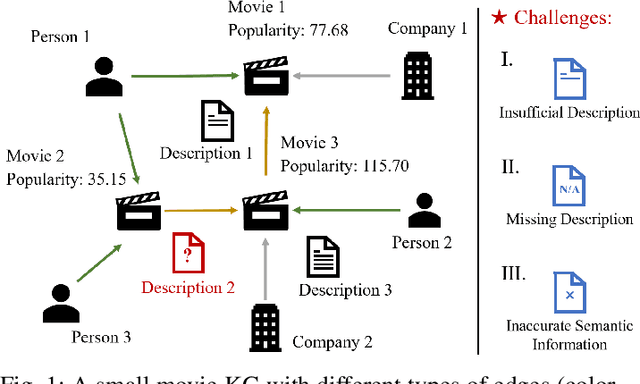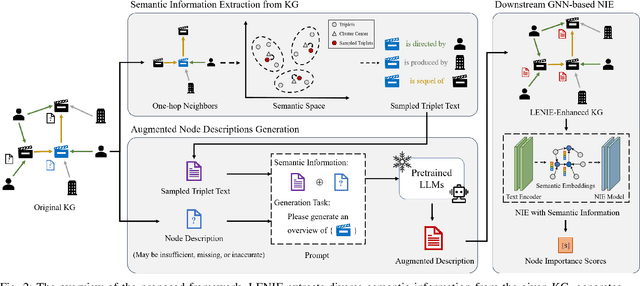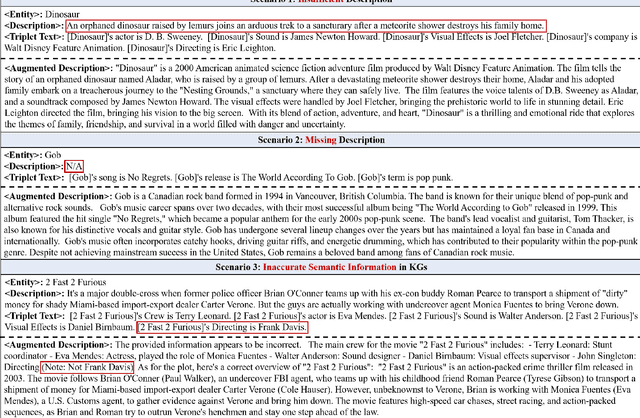Xinyu Lin
Navigating Through Paper Flood: Advancing LLM-based Paper Evaluation through Domain-Aware Retrieval and Latent Reasoning
Aug 07, 2025Abstract:With the rapid and continuous increase in academic publications, identifying high-quality research has become an increasingly pressing challenge. While recent methods leveraging Large Language Models (LLMs) for automated paper evaluation have shown great promise, they are often constrained by outdated domain knowledge and limited reasoning capabilities. In this work, we present PaperEval, a novel LLM-based framework for automated paper evaluation that addresses these limitations through two key components: 1) a domain-aware paper retrieval module that retrieves relevant concurrent work to support contextualized assessments of novelty and contributions, and 2) a latent reasoning mechanism that enables deep understanding of complex motivations and methodologies, along with comprehensive comparison against concurrently related work, to support more accurate and reliable evaluation. To guide the reasoning process, we introduce a progressive ranking optimization strategy that encourages the LLM to iteratively refine its predictions with an emphasis on relative comparison. Experiments on two datasets demonstrate that PaperEval consistently outperforms existing methods in both academic impact and paper quality evaluation. In addition, we deploy PaperEval in a real-world paper recommendation system for filtering high-quality papers, which has gained strong engagement on social media -- amassing over 8,000 subscribers and attracting over 10,000 views for many filtered high-quality papers -- demonstrating the practical effectiveness of PaperEval.
Self-Contradiction as Self-Improvement: Mitigating the Generation-Understanding Gap in MLLMs
Jul 22, 2025Abstract:Despite efforts to unify multimodal generation and understanding tasks in a single model, we show these MLLMs exhibit self-contradiction where generation produces images deemed misaligned with input prompts based on the model's own understanding. We define a Nonunified score that quantifies such self-contradiction. Our empirical results reveal that the self-contradiction mainly arises from weak generation that fails to align with prompts, rather than misunderstanding. This capability asymmetry indicates the potential of leveraging self-contradiction for self-improvement, where the stronger model understanding guides the weaker generation to mitigate the generation-understanding gap. Applying standard post-training methods (e.g., SFT, DPO) with such internal supervision successfully improves both generation and unification. We discover a co-improvement effect on both generation and understanding when only fine-tuning the generation branch, a phenomenon known in pre-training but underexplored in post-training. Our analysis shows improvements stem from better detection of false positives that are previously incorrectly identified as prompt-aligned. Theoretically, we show the aligned training dynamics between generation and understanding allow reduced prompt-misaligned generations to also improve mismatch detection in the understanding branch. Additionally, the framework reveals a potential risk of co-degradation under poor supervision-an overlooked phenomenon that is empirically validated in our experiments. Notably, we find intrinsic metrics like Nonunified score cannot distinguish co-degradation from co-improvement, which highlights the necessity of data quality check. Finally, we propose a curriculum-based strategy based on our findings that gradually introduces harder samples as the model improves, leading to better unification and improved MLLM generation and understanding.
$\text{R}^2\text{ec}$: Towards Large Recommender Models with Reasoning
May 22, 2025Abstract:Large recommender models have extended LLMs as powerful recommenders via encoding or item generation, and recent breakthroughs in LLM reasoning synchronously motivate the exploration of reasoning in recommendation. Current studies usually position LLMs as external reasoning modules to yield auxiliary thought for augmenting conventional recommendation pipelines. However, such decoupled designs are limited in significant resource cost and suboptimal joint optimization. To address these issues, we propose \name, a unified large recommender model with intrinsic reasoning capabilities. Initially, we reconceptualize the model architecture to facilitate interleaved reasoning and recommendation in the autoregressive process. Subsequently, we propose RecPO, a corresponding reinforcement learning framework that optimizes \name\ both the reasoning and recommendation capabilities simultaneously in a single policy update; RecPO introduces a fused reward scheme that solely leverages recommendation labels to simulate the reasoning capability, eliminating dependency on specialized reasoning annotations. Experiments on three datasets with various baselines verify the effectiveness of \name, showing relative improvements of 68.67\% in Hit@5 and 45.21\% in NDCG@20. Code available at https://github.com/YRYangang/RRec.
Collaboration of Large Language Models and Small Recommendation Models for Device-Cloud Recommendation
Jan 10, 2025Abstract:Large Language Models (LLMs) for Recommendation (LLM4Rec) is a promising research direction that has demonstrated exceptional performance in this field. However, its inability to capture real-time user preferences greatly limits the practical application of LLM4Rec because (i) LLMs are costly to train and infer frequently, and (ii) LLMs struggle to access real-time data (its large number of parameters poses an obstacle to deployment on devices). Fortunately, small recommendation models (SRMs) can effectively supplement these shortcomings of LLM4Rec diagrams by consuming minimal resources for frequent training and inference, and by conveniently accessing real-time data on devices. In light of this, we designed the Device-Cloud LLM-SRM Collaborative Recommendation Framework (LSC4Rec) under a device-cloud collaboration setting. LSC4Rec aims to integrate the advantages of both LLMs and SRMs, as well as the benefits of cloud and edge computing, achieving a complementary synergy. We enhance the practicability of LSC4Rec by designing three strategies: collaborative training, collaborative inference, and intelligent request. During training, LLM generates candidate lists to enhance the ranking ability of SRM in collaborative scenarios and enables SRM to update adaptively to capture real-time user interests. During inference, LLM and SRM are deployed on the cloud and on the device, respectively. LLM generates candidate lists and initial ranking results based on user behavior, and SRM get reranking results based on the candidate list, with final results integrating both LLM's and SRM's scores. The device determines whether a new candidate list is needed by comparing the consistency of the LLM's and SRM's sorted lists. Our comprehensive and extensive experimental analysis validates the effectiveness of each strategy in LSC4Rec.
Node Importance Estimation Leveraging LLMs for Semantic Augmentation in Knowledge Graphs
Nov 30, 2024



Abstract:Node Importance Estimation (NIE) is a task that quantifies the importance of node in a graph. Recent research has investigated to exploit various information from Knowledge Graphs (KGs) to estimate node importance scores. However, the semantic information in KGs could be insufficient, missing, and inaccurate, which would limit the performance of existing NIE models. To address these issues, we leverage Large Language Models (LLMs) for semantic augmentation thanks to the LLMs' extra knowledge and ability of integrating knowledge from both LLMs and KGs. To this end, we propose the LLMs Empowered Node Importance Estimation (LENIE) method to enhance the semantic information in KGs for better supporting NIE tasks. To our best knowledge, this is the first work incorporating LLMs into NIE. Specifically, LENIE employs a novel clustering-based triplet sampling strategy to extract diverse knowledge of a node sampled from the given KG. After that, LENIE adopts the node-specific adaptive prompts to integrate the sampled triplets and the original node descriptions, which are then fed into LLMs for generating richer and more precise augmented node descriptions. These augmented descriptions finally initialize node embeddings for boosting the downstream NIE model performance. Extensive experiments demonstrate LENIE's effectiveness in addressing semantic deficiencies in KGs, enabling more informative semantic augmentation and enhancing existing NIE models to achieve the state-of-the-art performance. The source code of LENIE is freely available at \url{https://github.com/XinyuLin-FZ/LENIE}.
Efficient Inference for Large Language Model-based Generative Recommendation
Oct 07, 2024



Abstract:Large Language Model (LLM)-based generative recommendation has achieved notable success, yet its practical deployment is costly particularly due to excessive inference latency caused by autoregressive decoding. For lossless LLM decoding acceleration, Speculative Decoding (SD) has emerged as a promising solution. However, applying SD to generative recommendation presents unique challenges due to the requirement of generating top-K items (i.e., K distinct token sequences) as a recommendation list by beam search. This leads to more stringent verification in SD, where all the top-K sequences from the target LLM must be successfully drafted by the draft model at each decoding step. To alleviate this, we consider 1) boosting top-K sequence alignment between the draft model and the target LLM, and 2) relaxing the verification strategy to reduce trivial LLM calls. To this end, we propose an alignment framework named AtSpeed, which presents the AtSpeed-S optimization objective for top-K alignment under the strict top-K verification. Moreover, we introduce a relaxed sampling verification strategy that allows high-probability non-top-K drafted sequences to be accepted, significantly reducing LLM calls. Correspondingly, we propose AtSpeed-R for top-K alignment under this relaxed sampling verification. Empirical results on two real-world datasets demonstrate that AtSpeed significantly accelerates LLM-based generative recommendation, e.g., near 2x speedup under strict top-K verification and up to 2.5 speedup under relaxed sampling verification. The codes and datasets will be released in the near future.
Unveiling Advanced Frequency Disentanglement Paradigm for Low-Light Image Enhancement
Sep 03, 2024



Abstract:Previous low-light image enhancement (LLIE) approaches, while employing frequency decomposition techniques to address the intertwined challenges of low frequency (e.g., illumination recovery) and high frequency (e.g., noise reduction), primarily focused on the development of dedicated and complex networks to achieve improved performance. In contrast, we reveal that an advanced disentanglement paradigm is sufficient to consistently enhance state-of-the-art methods with minimal computational overhead. Leveraging the image Laplace decomposition scheme, we propose a novel low-frequency consistency method, facilitating improved frequency disentanglement optimization. Our method, seamlessly integrating with various models such as CNNs, Transformers, and flow-based and diffusion models, demonstrates remarkable adaptability. Noteworthy improvements are showcased across five popular benchmarks, with up to 7.68dB gains on PSNR achieved for six state-of-the-art models. Impressively, our approach maintains efficiency with only 88K extra parameters, setting a new standard in the challenging realm of low-light image enhancement.
Learnable Tokenizer for LLM-based Generative Recommendation
May 12, 2024Abstract:Harnessing Large Language Models (LLMs) for generative recommendation has garnered significant attention due to LLMs' powerful capacities such as rich world knowledge and reasoning. However, a critical challenge lies in transforming recommendation data into the language space of LLMs through effective item tokenization. Existing approaches, such as ID identifiers, textual identifiers, and codebook-based identifiers, exhibit limitations in encoding semantic information, incorporating collaborative signals, or handling code assignment bias. To address these shortcomings, we propose LETTER (a LEarnable Tokenizer for generaTivE Recommendation), designed to meet the key criteria of identifiers by integrating hierarchical semantics, collaborative signals, and code assignment diversity. LETTER integrates Residual Quantized VAE for semantic regularization, a contrastive alignment loss for collaborative regularization, and a diversity loss to mitigate code assignment bias. We instantiate LETTER within two generative recommender models and introduce a ranking-guided generation loss to enhance their ranking ability. Extensive experiments across three datasets demonstrate the superiority of LETTER in item tokenization, thereby advancing the state-of-the-art in the field of generative recommendation.
A Survey of Generative Search and Recommendation in the Era of Large Language Models
Apr 25, 2024



Abstract:With the information explosion on the Web, search and recommendation are foundational infrastructures to satisfying users' information needs. As the two sides of the same coin, both revolve around the same core research problem, matching queries with documents or users with items. In the recent few decades, search and recommendation have experienced synchronous technological paradigm shifts, including machine learning-based and deep learning-based paradigms. Recently, the superintelligent generative large language models have sparked a new paradigm in search and recommendation, i.e., generative search (retrieval) and recommendation, which aims to address the matching problem in a generative manner. In this paper, we provide a comprehensive survey of the emerging paradigm in information systems and summarize the developments in generative search and recommendation from a unified perspective. Rather than simply categorizing existing works, we abstract a unified framework for the generative paradigm and break down the existing works into different stages within this framework to highlight the strengths and weaknesses. And then, we distinguish generative search and recommendation with their unique challenges, identify open problems and future directions, and envision the next information-seeking paradigm.
The 2nd Workshop on Recommendation with Generative Models
Mar 07, 2024
Abstract:The rise of generative models has driven significant advancements in recommender systems, leaving unique opportunities for enhancing users' personalized recommendations. This workshop serves as a platform for researchers to explore and exchange innovative concepts related to the integration of generative models into recommender systems. It primarily focuses on five key perspectives: (i) improving recommender algorithms, (ii) generating personalized content, (iii) evolving the user-system interaction paradigm, (iv) enhancing trustworthiness checks, and (v) refining evaluation methodologies for generative recommendations. With generative models advancing rapidly, an increasing body of research is emerging in these domains, underscoring the timeliness and critical importance of this workshop. The related research will introduce innovative technologies to recommender systems and contribute to fresh challenges in both academia and industry. In the long term, this research direction has the potential to revolutionize the traditional recommender paradigms and foster the development of next-generation recommender systems.
 Add to Chrome
Add to Chrome Add to Firefox
Add to Firefox Add to Edge
Add to Edge